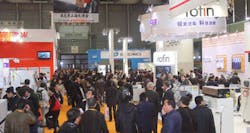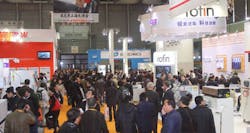Photonics shows strength in Shanghai
Nashau, NH -- Conard Holton, Editor in Chief/Associate Publisher of Laser Focus World (sister publication to Industrial Laser Solutions), comments on the Laser World of Photonics -- Shanghai Show and Congress he recently attended in China.
Since first opening in 2006, LASER World of Photonics China has established itself as the leading lasers and optics tradeshow in China. It was very clear to me how energized the exhibitors and attendees were by the diversity and quality of products on display, the rapidly increasing scale of the industry in China, and the international feel of the event.
The show ran from March 20-22 in Shanghai's New International Expo Center, and attracted 475 exhibitors from 19 countries, an increase of 32 percent from 2011. The number of visitors reached 34,300, a 19 percent growth over last year. The total exhibition space increased to 23,000 sq m, up 33 percent from 2011.
Most of the major North American and European manufacturers of lasers, optics, and cameras exhibited at the show. Some were able to benefit from many years of operating subsidiaries in China; for example, Avantes China held a celebration marking its fifth anniversary and disclosed plans for growth that included expanding from four to five locations.
The vast majority of exhibitors were Chinese, including names increasingly familiar to me such as Castech, China Daheng Group, Crystech, Han's Laser Technology, Luster LightTech, Pinnacle Scientific, Wuhan HuaGong Laser Engineering, Wuhan Raycus Fiber Laser Technologies, and Xi'an FocusLight Technologies. A section of one hall was devoted to the Machine Vision Exhibition Pavilion, which attracted approximately 100 Chinese and international exhibitors.
The Photonics Congress China was held in parallel to the tradeshow and featured the International Conference on Laser Processes and Components, the Conference on Laser Technology and Optoelectronics, an OIDA Fiber Communications Workshop, and the OSA Energy Photonics Workshop. During the Laser Processes and Components conference, I presented some of the global laser marketplace data researched by Strategies Unlimited, a summary of which was published in Laser Focus World.
The audience of approximately 300 also heard from Prof. Youliang Wang, Chinese Optical Society Laser Processing Committee, who discussed the state of the laser industry in China. The first point he made was that the central government is firmly behind the industry. The current president of China and general secretary of the Communist Party, Hu Jintao, has said, "We should redouble our efforts to research, produce, and use lasers."
Wang also noted that two laser companies are now listed on the Shenzhen Stock Exchange (SXSE): Wuhan Golden Laser (SHE: 300220) and Shenzhen Sunshine Laser and Electronics (SHE: 300227). He said that the laser processing industry is growing quickly and embracing fiber lasers, but that much work needs to be done. According to Wang, there are 50 domestic high-power laser companies but only 13 of them are well known and have a strong intellectual property position and R&D operations.
He urged the domestic laser industry to become more "self-directed" and innovative, and to overcome the lack of management experience, R&D, and skilled technicians. He further stressed that China must avoid becoming just another laser marking market.
Dr. Bo Gu, a well-known figure in the industry who has held management positions in both China and the US, also spoke on China and the global laser industry. He first urged the Chinese laser industry to develop a leader mentality. China has trailed in the invention and development of new technologies by only a few years, including laser technologies. However, "the cost of being second is huge."
Higher margins go to the leaders (up to 60 percent) -- as latecomers enter markets, prices and margins drop. Market data from Strategies Unlimited shows that approximately 90 percent of the value of the global laser industry now comes from companies headquartered in the US, Germany, or Japan.
Gu said that the advancement of lasers and laser technology was called for in the government's Twelth Five-Year Plan and that once such a commitment was made, resources were allocated to ensure it happened. To drive this change, Gu said Chinese companies should:
- Invest in R&D
- Acquire overseas companies or create joint ventures (which may not provide access to leading edge technologies but might reduce the trailing time)
- Participate in exchange programs with international companies (given the political world, probably more feasible with European companies)
- Invest in and set up overseas centers to attract talent and learn (probably only feasible for larger companies such as Huawei).
Shanghai was a noticeably different city from the one I visited five years ago while attending another tradeshow. In a sense, the Chinese laser market is growing and changing even faster than the social and infrastructure changes that are transforming the country. Hoping to keep pace, I'll be writing much more about the industry in this blog and in the pages of Laser Focus World.


